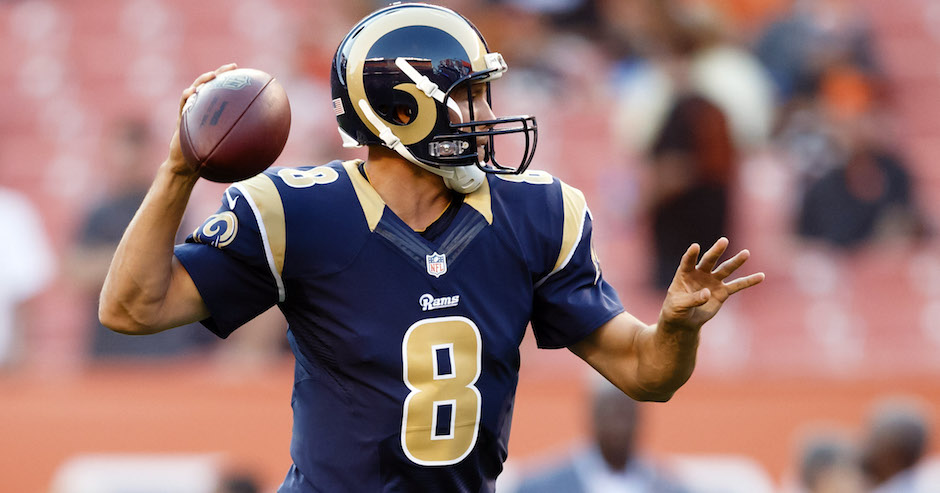Making Sense Of the Foles-Bradford Deal
Chip Kelly had just completed his first draft as an NFL head coach, and he stood behind the podium at the NovaCare Complex explaining some of the Eagles’ selections.
He seemed excited about Lane Johnson and the other picks the team had made. He was another step closer to getting the new guys on the practice field during OTAs and mini-camps.
While discussing the picks, Kelly was asked about the importance of measurables in identifying players for his scheme.
“If you constantly take the overachiever at every position, you’re going to be too small,” Kelly said. “If you take the short defensive tackle backed up by the short middle linebacker backed up by the short safety, then all of a sudden your team’s going to get run over.”
The explanation made perfect sense and was refreshing to many. Others in the league have put it more succinctly: Don’t get into trouble by trying to build a team of exceptions.
On Tuesday, Kelly pulled a stunner and sent Nick Foles to the St. Louis Rams in exchange for Sam Bradford. All offseason, it seemed Kelly had a plan. There had to be some reason why he traded LeSean McCoy, didn’t overpay for Jeremy Maclin and brought Mark Sanchez back.
Perhaps he was looking to invest in the defense and let the system work its magic on the offensive side of the ball. Maybe he was planning a trade-up for Marcus Mariota and needed to clear cap space to fill the glaring holes on the roster. Given his power play to oust Howie Roseman, anything seemed possible, and there were no checks and balances. The team would be built 100 percent in Kelly’s vision.
But the big move ended up being one nobody saw coming: acquiring Bradford, a 27-year-old quarterback who has suffered ACL injuries in each of the past two seasons and has made seven starts since 2013. When healthy, Bradford has completed 58.6 percent of his passes, averaged 6.3 YPA and tossed 59 touchdowns against 38 interceptions.
Only three active quarterbacks have attempted at least 1,700 passes, completed worse than 59 percent of their passes and averaged under 6.7 YPA. Two are on the Eagles: Sanchez and Bradford. The other is Matt Cassel.
Some will point out that he wasn’t surrounded by great talent in St. Louis, completely ignoring that McCoy and Maclin are gone. Bradford’s No. 1 option on the outside currently in Philadelphia is Riley Cooper.
In other words, Kelly is counting on Bradford to be the exception. He’s hoping Bradford can stay healthy and resurrect his career in a new home with a new scheme and a new coaching staff.
The truth is that getting rid of Foles was perfectly sensible. He was entering the final year of his deal, and if Kelly didn’t think Foles was the guy, might as well get something for him.
It’s even perfectly fine to take a flier on Bradford. His 2.2 percent interception rate is third among active QBs behind only Aaron Rodgers and Tom Brady. Maybe Bradford is the decision-maker Kelly covets. Maybe the scheme will help with the other stuff. Maybe the sports science program will have him feeling better than he ever has.
The problem is what it took to land Bradford and what it reveals about Kelly, the personnel man. The Eagles, a team that still needs to address safety, wide receiver, offensive line and other areas, took on north of $12 million in salary. Additionally, they gave up a 2016 second-round pick. Think that’s no big deal? The last three second-rounders for the Birds have landed Mychal Kendricks, Zach Ertz and Jordan Matthews.
It’s fair to give Kelly the entire offseason to see what the product looks like going into August, but it’s equally reasonable to wonder whether all of the concerns about him being in charge of personnel are proving to be spot-on.
Could the Eagles have landed Bradford for less? Was the competition really that fierce for a guy with a $12M salary coming off of two torn ACLs? Did the Eagles get fleeced?
The reason there is so much skepticism in Philadelphia is simple: Kelly can leave, but the fans are stuck with this team. That’s just how it is. He can blow up the roster, get rid of superstars who don’t fit his mold and roll the dice on a player like Bradford. If it works out, great. If it doesn’t, he will have options. Jeffrey Lurie, meanwhile, will be left to pick up the pieces and find help in rebuilding a roster that has serious holes.
If the Bradford trade is part of some bigger plan, everyone will be granted the option of revising their opinions and reassessing the situation.
But for now, we can only go off of what we know. Even when stepping back and looking at it from every different angle, it’s tough to make sense of what Kelly was hoping to pull off with the move he made Tuesday.
